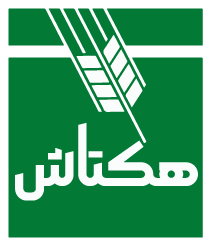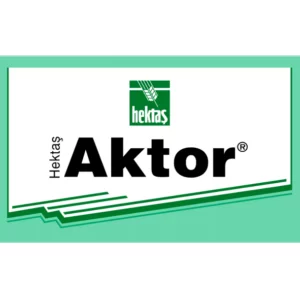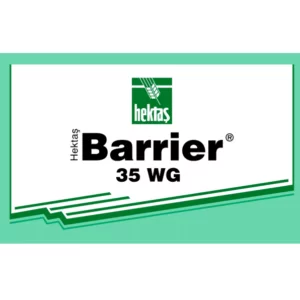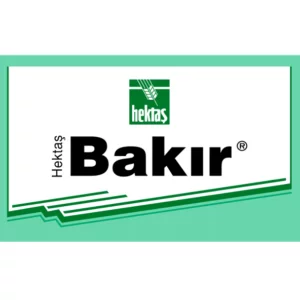Specifications
It is a protective fungicide.
Method of Application
Apple scribble:
1st application: when the flower buds swell (3-5 days earlier, where there is a row of branches);
2nd application: during the pink rosette bud period (when the individual flowers appear);
3rd application when 70-80% of flower petals fall;
4. and other applications should be done with 15 days intervals when the climatic conditions are suitable for the progression of the disease.
Pear scatter:
1st application: When the flower buds swell (3-5 days ago in places with rows of branches)
2nd application: During the white badge period
3rd application: When 70-80% of flower petals fall
4. and other applications should be applied with an interval of 10 days, taking into account the effect times of the plant protection product used.
Pear mammal rust:
1st application: just before the flower buds burst,
2nd application: flower in white rosette circuit,
3rd application: when 80-90% of flower petals fall,
Generally, 3 applications are sufficient, but in climatic conditions where the spring is rainy, other applications are continued until the rains end, taking into account the effect time of the plant protection product.
Leaf piercing (freckle) in stone fruits (Apricot, Peach):
1st application: Immediately after leaf fall in autumn,
2nd application: Before the flower buds open in the spring (during the pink flower bud period),
In addition to apricots, the third spraying should be done while separating the sepals and stamen plate on the fruit.
Pocket disease in plums:
1. application: During the period when the buds swell,
2nd application: It should be done when 80% of the flower petals fall.
Black pepper in pistachios:
1st application: If the fight with protective fungicides is to be made, the applications must be before the first infections, during the period when the leaves begin to open; If therapeutic fungicides are to be combated, the fruits should be as large as chickpeas and when the leaves are fully opened. In addition, therapeutic fungicides can be applied until the first symptoms are seen.
2nd application and other applications: It is done at 15-day intervals, taking into account the characteristics of the plant protection product used, its duration of action and precipitation.
Tip-drying in citrus:
Green parts applications: It should be done 3 times in October, December and March.
Soil applications: In addition to green parts spraying, heavily infected trees in the garden should be sprayed once in October.
Ringed stain on olives:
In the Marmara Region:
1st application: Just before autumn shoots appear
2nd application: after the flower stalks become evident, before the flowers open
In the Aegean Region:
1st application: Just before the spring shoots appear
2nd application: after the flower stalks become evident, before the flowers open
In the Mediterranean Region:
1st application: After harvest
2nd application: Just before the spring shoots appear
3rd application: It should be done after the flower stalks become evident, before the flowers open.
Vineyard mildew:
1st application: It should be applied when the shoot length is 25-30 cm.
2nd and other applications: It should be done 15 days after the first application. Considering the meteorological factors such as daily temperature and precipitation averages of the region, relative humidity, and dew, applications should be made when suitable conditions for disease infection occur, and applications should be terminated when the conditions disappear.
Vineyard anthracnose:
Winter application: After the vines are pruned, it should be applied in the period when the eyes have not yet awakened.
Summer application: When the vineyard mildew is applied according to phenology, there is no need for an additional summer application for vineyard anthracnose. If separate spraying is required, the following program is applied.
1st application: Shoots 5-10 cm
2. and other applications: It is done by considering the effect time of the fungicide used in the first application. Applications are continued until the grains reach half their size.
Spraying is not recommended during the flowering period.
Tomato downy mildew: Application is started when a white ash-like conidy cover is seen on the underside of brown spots with a diameter of 3-5 mm on tomato leaves.
Potato downy mildew: The application is started when climatic conditions such as high humidity occur for disease emergence or when the first signs of disease are seen in the environment, and the application is repeated at 10-day intervals depending on the severity of the disease.
Bean anthracnose: Applications should be started as soon as the first signs of disease are seen in the region. The application is continued considering the severity of the disease, climatic conditions and the duration of the plant protection product. Care should be taken to spray all the green parts of the plant.
Tomato, Eggplant, Potato early blight: The application should be started as soon as the first spots appear, both in the nursery and in the field. When climatic conditions are suitable for disease development, applications are continued at 10-day intervals depending on the course of the disease and climatic conditions.
Settling and root rot in vegetable seedlings:
Applications are made in the form of seed and soil spraying.
Seed spraying: It is applied to the seed before planting.
Soil spraying: It is done before planting, after planting, after the emergence of the seedlings to the soil surface and after the seedlings are transplanted into the greenhouse or field.
Cucumber angular leaf spot: It should be applied at least 3 applications with 10-day intervals before the disease appears in the field or when it first appears.
Hops downy mildew: In the spring, spraying is started when the shoots are 75-100 cm in average. It is repeated with an interval of one week until the flowering period. In this period, spraying is continued at 10-day intervals until the cocoon holding period.
Safflower leaf spot: Applications are started when the first symptoms are seen on the plants.
Settling in tobacco seedlings: It is done when the disease is seen after the seeds are planted and covered with cover fertilizer or after the seedlings have emerged. Spraying to be done as soon as the disease is seen is applied once a week until the surprise period.
Bacterial spot on tomato: As soon as disease symptoms are seen in the nursery or in the field, it should be applied as a preventative, once a week during the seedling period, and 2-3 applications with an interval of 8-10 days in the field. The number of applications can be increased in greenhouses.
Tomato bacterial stain: The fight against bacterial stain is carried out in the form of green parts application. As soon as the disease symptoms are seen in the nursery or in the field, green parts should be applied once a week during the seedling period and 2-3 applications should be made at 10 days intervals in the field.
Bean common leaf blight and halo blight: It should be applied as 2-3 applications, once a week, before the disease appears in the field or when it first appears.
Cercospora early leaf spot in peanut: The application is started 4-5 weeks after planting in places where the disease occurs every year, and can be continued until harvest.
Other Informations
Miscibility:
Crop protection products with Cymoxanil, Methiram, Folpet compositions can be mixed. It is undesirable to mix with Chlorpyrifos, Malathion, Phosmet, Carbamat based plant protection products and Dodine.
Detailed Table Information
Vineyard: It is not used in vineyard areas where vineyard leaves for consumption will be harvested.
**As the development of tomato plants may stagnate, the recommendation of copper-based drugs should be avoided in arid climate conditions, however, in places where organic fungicides are not available, a maximum of 1-2 applications should be made with copper-based drugs.
| NAME OF THE PRODUCT | PLANT NAME | ETMEN ADI | DOSAGE OF USE | TIME BETWEEN LAST SPRAY AND HARVEST |
|---|---|---|---|---|
| Hektaş Bakır | Olive |
Ringed Stain (Spilocaea oleaginum)
|
400 g / 100 L water | 21 day |
| Hektaş Bakır | Peanut |
Cercospora early leaf spot (Cercospora arachidicola)
|
400 g/100 L water | 14 day |
| Hektaş Bakır | Tobacco |
collapsed (Rhizoctonia solani)
|
400 g / 100 L water | 14 day |
| Hektaş Bakır | Citrus |
bitblower(Phoma tracheiphila)
|
400 g / 100 L water | 21 day |
| Hektaş Bakır | Hops |
Mildew (Pseudoperonospora humuli)
|
500 g / 100 L water | 14 day |
| Hektaş Bakır | Peach |
leaf curl (Taphrina deformans)
|
800 g/100 L water | 21 day |
| Hektaş Bakır | Peach |
Peach Leaf puncher in stone fruits (Wilsonomyces carpophilus)
|
400 g / 100 L water1. Application, 800 g / 100 L water 2. Application | 21 day |
| Hektaş Bakır | vegetable seedlings |
Rubbing and root rot (Pythium spp.,Rhizoctonia spp., Fusarium spp., Alternaria spp., Sclerotinia spp.,Phytophthora spp.)
|
300 g / 100 L water 1.Application, 500 g / 100 L water 2.Application(nursery application) | 14 day |
| Hektaş Bakır | Aubergine |
early leaf blight (Alternaria solani)
|
500 g/100 L water | 14 day |
| Hektaş Bakır | Potatoes |
Mildew (Phythophthora infestans)
|
300 g / 100 L water | 14 day |
| Hektaş Bakır | Potatoes |
early leaf blight (Alternaria solani)
|
500 g/100 L water | 14 day |
| Hektaş Bakır | Apricot |
Leaf Piercing in Hard Seed Fruits (Wilsonomyces carpophilus)
|
400 g / 100 L water normal period, 800 g / 100 L water dormant period | 21 day |
| Hektaş Bakır | Cucumber |
leathery leaf spot (Pseudomonas syringae pv.lachyrmans)
|
300 g / 100 L water | 14 day |
| Hektaş Bakır | Beans |
halo blight (Pseudomonas savastanoi pv. phaseolica)
|
300 g/100 L water | 14 day |
| Hektaş Bakır | Beans |
anthracnose (Colletotrichum lindemuthianum)
|
500 g / 100 L water | 14 day |
| Hektaş Bakır | Beans |
common leaf blight (Xanthomonas axonopodis pv. phaseoli)
|
300 g/100 L water | 14 day |
| Hektaş Bakır | Plum |
pocket disease(Taphrina pruni)
|
800 g / 100 L water | 21 day |
| Hektaş Bakır | Apple |
Black stain (Venturia inaequalis)
|
If there is 800 g / 100 L water twig, if there is no 400 g / 100 L water twig | 21 day |
| Hektaş Bakır | Tomato |
Mildew (Phytophthora infestans)
|
300 g / 100 L water | 14 day |
| Hektaş Bakır | Tomato |
early leaf blight (Alternaria solani)
|
500 g/100 L water | 14 day |
| Hektaş Bakır | Tomato |
bacterial spot (Xanthomonas vesicatoria)
|
300 g/100 L water 1.Application 400 g/100 L water 2.Application | 14 day |
| Hektaş Bakır | Tomato |
bacterial spot (Pseudomonas syringae pv. tomato)
|
300 g/100 L water 1.Application 400 g/100 L water 2.Application | 14 day |
| Hektaş Bakır | Bond* |
Mildew(Plasmopara viticola)
|
300 g / 100 L water 1. Application, 500 g / 100 L water 2. Application | 21 day |
| Hektaş Bakır | Bond* |
anthracnose (Elsince ampelina)
|
300 g / 100 L water 1. Application, 500 g / 100 L water 2. Application | 21 day |
| Hektaş Bakır | Safflower |
leaf spot (Pseudomonas syringae)
|
300 g / 100 L water | 14 day |
| Hektaş Bakır | Pear |
mammal rust (Gymnosporangium fuscum)
|
400 g / 100 L water | 21 day |
| Hektaş Bakır | Pear |
Black stain(Venturia pyrina)
|
If there is 800 g / 100 L water twig, if there is no 400 g / 100 L water twig | 21 day |
| Hektaş Bakır | pistachios |
Karazenk (Pseudocercospora pistacina)
|
500 g / 100 L water | 21 day |




نقد و بررسیها
حذف فیلترهاهیچ دیدگاهی برای این محصول نوشته نشده است.